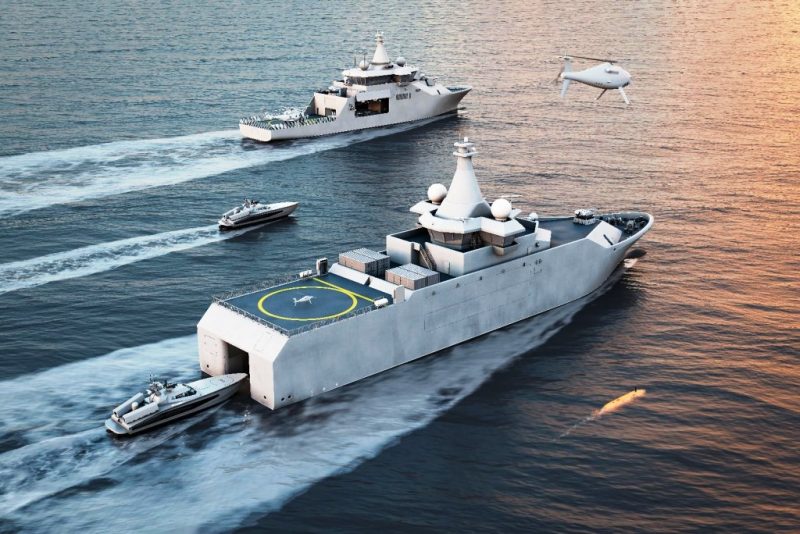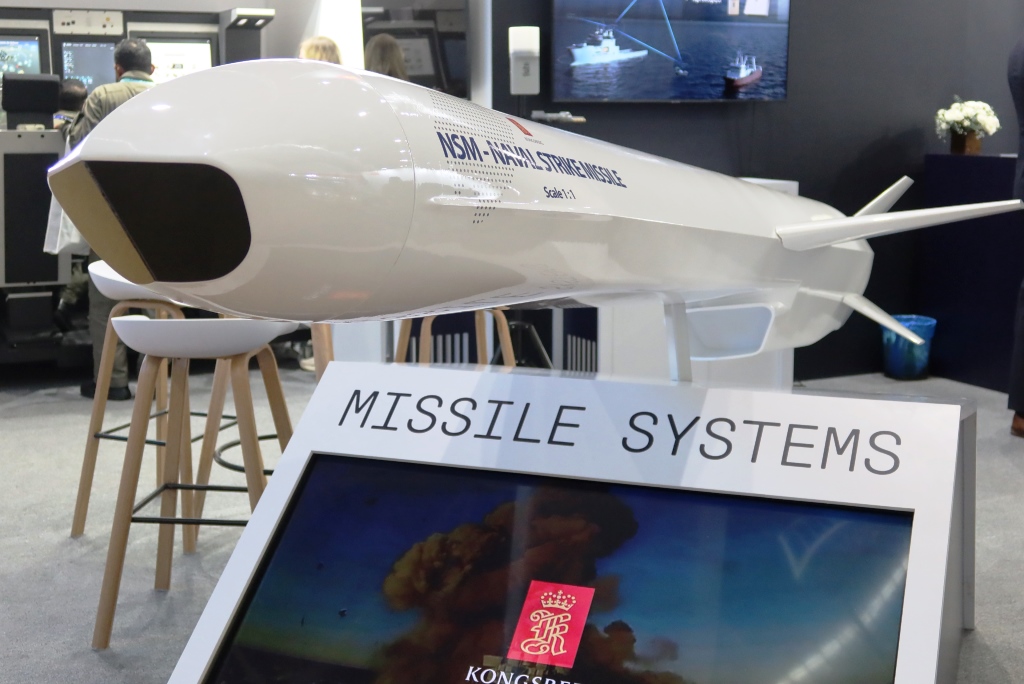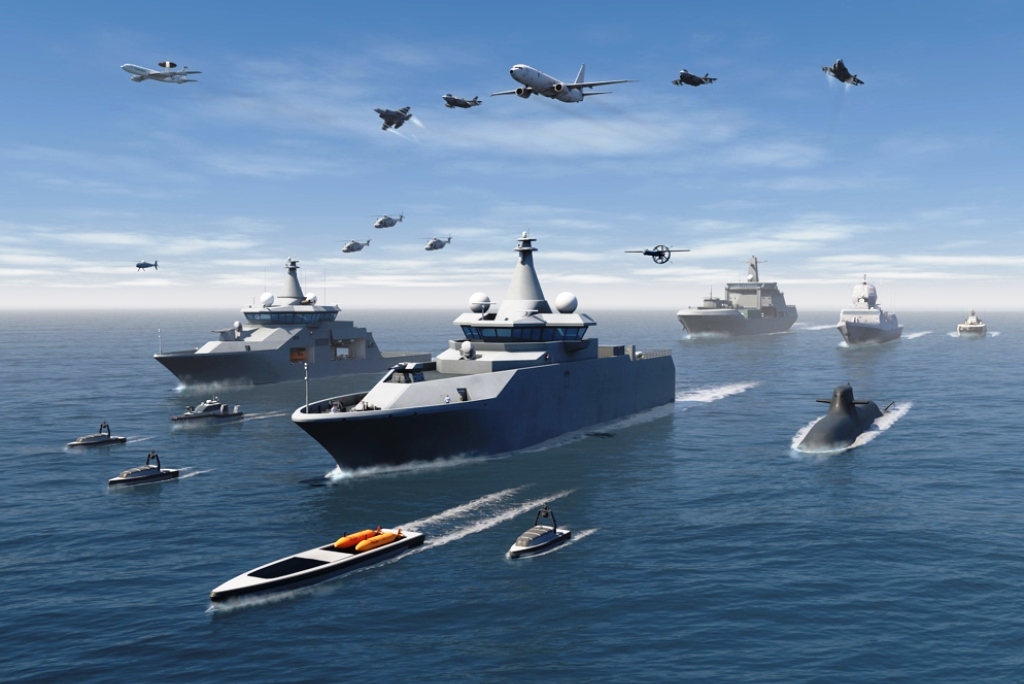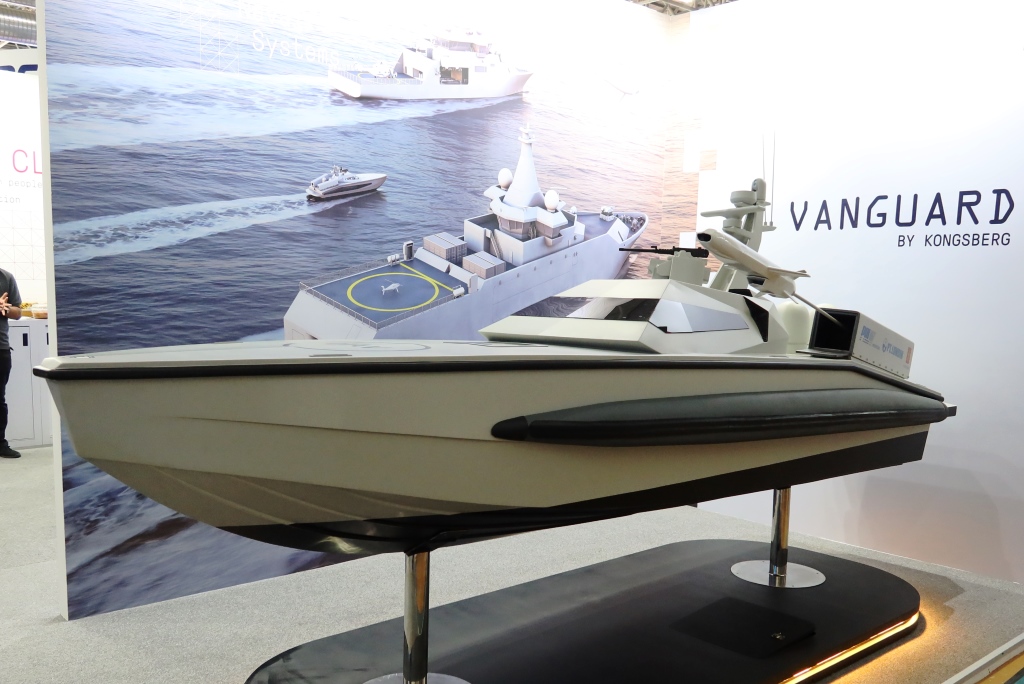⚓️ LIMA 2023  Images courtesy Kongsberg. (Photos by P. Valpolini)
Images courtesy Kongsberg. (Photos by P. Valpolini)
With the cancelling of the 2021 edition of LIMA due to the pandemic, this year edition of the Langkawi exhibition allowed Kongsberg of Norway to promote its Vanguard system, based on a mothership/fast attack boats concept, to Malaysia.
Launched in 2019 by Kongsberg, the Vanguard system is being actively market in Asia, where the Norwegian company believes the geography fits well the mothership/fast attack boat concept.
In 2022 at Indo Defence Kongsberg and PT Lundin signed a Memorandum of Understanding with PT PAL of Indonesia for the development a new type of vessel called locally KSR (Kapal Serang Ringan, for light attack craft).
 At LIMA 2023 the Kongsberg stand was dominated by its Naval Strike Missile (NSM) which is already bought by Malaysia and of course proposed for the two main Malaysian programmes, the LCS (Littoral Combat Ship) and the LMS (Littoral Mission Ship) Batch 2, and by the model of its fast attack craft (FAC) part of the Vanguard system, fitted with two NSMs.
At LIMA 2023 the Kongsberg stand was dominated by its Naval Strike Missile (NSM) which is already bought by Malaysia and of course proposed for the two main Malaysian programmes, the LCS (Littoral Combat Ship) and the LMS (Littoral Mission Ship) Batch 2, and by the model of its fast attack craft (FAC) part of the Vanguard system, fitted with two NSMs.
The Vanguard concept is based on a mothership, capable to carry up to four FACs. The mothership is built to IMO (International Maritime Organization) standards used for commercial vessels, however reinforcements are installed in specific areas to allow the installation of communication equipment as well as the handling of weapons. A frigate-size ship, the mothership is 100 metres long, has an 18 metres beam, the crew being of 30 persons, however cabins for 100 persons are available. It is fitted with a diesel-electric propulsion that ensures a range of 5,000 NM at cruise speed, the ship being also fitted with a replenishment-at-sea system.
 It has a well deck allowing operating the FACs, which are of course controlled from on-board the ship that is fitted with all necessary workstations and communication means. It is also fitted with a flight deck capable to host light helicopters as well as VTOL UAVs, and a wide area where up to twenty 20-foot containers can be hosted. Weaponry is limited to the bow-mounted medium-calibre gun.
It has a well deck allowing operating the FACs, which are of course controlled from on-board the ship that is fitted with all necessary workstations and communication means. It is also fitted with a flight deck capable to host light helicopters as well as VTOL UAVs, and a wide area where up to twenty 20-foot containers can be hosted. Weaponry is limited to the bow-mounted medium-calibre gun.
The FACs are designed by PT Lundin and beside the aforementioned NSM missiles they also carry a Kongsberg RS4 remotely controlled weapon station armed with a 12.7 mm calibre machine gun. They can be operated unmanned, controlled by the Vanguard mothership, or carry a crew of six. Fully made of carbon fibre, the FAC is 19 metres long and is powered by two waterjets provided by Kongsberg that allow the boat to exceed 50 knots.
When operating in autonomous mode the FAC can be controlled by line-of-sight data ink or fitted with a SATCOM link, should it operate in areas with numerous islands, such as the Malay Archipelago with its over 25,000 islands that form the states of Brunei, East Timor, Indonesia, Malaysia, Papua New Guinea, the Philippines, Singapore, Christmas Island, and Cocos Islands. Losing the line-of-sight between the mothership and the unmanned FAC in such areas is pretty easy, hence the importance of a robust SATCOM system.
As for navigation, the FACs obviously use an integrated GNSS/INSS system, however should the GNSS signal be jammed or spoofed, they can also rely on other systems allowing the refresh of the inertial platform; one of the systems is a derivative of that used on Kongsberg’s Hugin family of unmanned underwater system, which exploits the sea bottom to ensure pinpoint localisation. Other undisclosed systems based on radiofrequency also ensure precise navigation in GNSS-denied scenarios.
 The attack configuration is only one of those proposed by Kongsberg; removing the two missiles would provide enough space for embarking other types of modules. Depending on the module installed FACs can carry out different missions such as exercise of authority and sovereignty, harbour protection, search and rescue, hydrographic survey, area denial, antisubmarine warfare or mine clearance. Typically a towed array sonar is installed for mine countermeasure or antisubmarine warfare missions.
The attack configuration is only one of those proposed by Kongsberg; removing the two missiles would provide enough space for embarking other types of modules. Depending on the module installed FACs can carry out different missions such as exercise of authority and sovereignty, harbour protection, search and rescue, hydrographic survey, area denial, antisubmarine warfare or mine clearance. Typically a towed array sonar is installed for mine countermeasure or antisubmarine warfare missions.
The agreement with PT Lundin will see the first KSR launched in Q4 2024. This will be the first step of the programme, the net one being the building of the mothership by PT PAL, as well as that of other KSRs, to fully enforce the Vanguard system concept. Considering the relationship between Indonesia and Malaysia, Kongsberg considers the MoU with PT Lundin and PT PAL a point of entry in the Asian region.
 Images courtesy Kongsberg. (Photos by P. Valpolini)
Images courtesy Kongsberg. (Photos by P. Valpolini) With the cancelling of the 2021 edition of LIMA due to the pandemic, this year edition of the Langkawi exhibition allowed Kongsberg of Norway to promote its Vanguard system, based on a mothership/fast attack boats concept, to Malaysia.
Launched in 2019 by Kongsberg, the Vanguard system is being actively market in Asia, where the Norwegian company believes the geography fits well the mothership/fast attack boat concept.
In 2022 at Indo Defence Kongsberg and PT Lundin signed a Memorandum of Understanding with PT PAL of Indonesia for the development a new type of vessel called locally KSR (Kapal Serang Ringan, for light attack craft).
 At LIMA 2023 the Kongsberg stand was dominated by its Naval Strike Missile (NSM) which is already bought by Malaysia and of course proposed for the two main Malaysian programmes, the LCS (Littoral Combat Ship) and the LMS (Littoral Mission Ship) Batch 2, and by the model of its fast attack craft (FAC) part of the Vanguard system, fitted with two NSMs.
At LIMA 2023 the Kongsberg stand was dominated by its Naval Strike Missile (NSM) which is already bought by Malaysia and of course proposed for the two main Malaysian programmes, the LCS (Littoral Combat Ship) and the LMS (Littoral Mission Ship) Batch 2, and by the model of its fast attack craft (FAC) part of the Vanguard system, fitted with two NSMs.The Vanguard concept is based on a mothership, capable to carry up to four FACs. The mothership is built to IMO (International Maritime Organization) standards used for commercial vessels, however reinforcements are installed in specific areas to allow the installation of communication equipment as well as the handling of weapons. A frigate-size ship, the mothership is 100 metres long, has an 18 metres beam, the crew being of 30 persons, however cabins for 100 persons are available. It is fitted with a diesel-electric propulsion that ensures a range of 5,000 NM at cruise speed, the ship being also fitted with a replenishment-at-sea system.
 It has a well deck allowing operating the FACs, which are of course controlled from on-board the ship that is fitted with all necessary workstations and communication means. It is also fitted with a flight deck capable to host light helicopters as well as VTOL UAVs, and a wide area where up to twenty 20-foot containers can be hosted. Weaponry is limited to the bow-mounted medium-calibre gun.
It has a well deck allowing operating the FACs, which are of course controlled from on-board the ship that is fitted with all necessary workstations and communication means. It is also fitted with a flight deck capable to host light helicopters as well as VTOL UAVs, and a wide area where up to twenty 20-foot containers can be hosted. Weaponry is limited to the bow-mounted medium-calibre gun.The FACs are designed by PT Lundin and beside the aforementioned NSM missiles they also carry a Kongsberg RS4 remotely controlled weapon station armed with a 12.7 mm calibre machine gun. They can be operated unmanned, controlled by the Vanguard mothership, or carry a crew of six. Fully made of carbon fibre, the FAC is 19 metres long and is powered by two waterjets provided by Kongsberg that allow the boat to exceed 50 knots.
When operating in autonomous mode the FAC can be controlled by line-of-sight data ink or fitted with a SATCOM link, should it operate in areas with numerous islands, such as the Malay Archipelago with its over 25,000 islands that form the states of Brunei, East Timor, Indonesia, Malaysia, Papua New Guinea, the Philippines, Singapore, Christmas Island, and Cocos Islands. Losing the line-of-sight between the mothership and the unmanned FAC in such areas is pretty easy, hence the importance of a robust SATCOM system.
As for navigation, the FACs obviously use an integrated GNSS/INSS system, however should the GNSS signal be jammed or spoofed, they can also rely on other systems allowing the refresh of the inertial platform; one of the systems is a derivative of that used on Kongsberg’s Hugin family of unmanned underwater system, which exploits the sea bottom to ensure pinpoint localisation. Other undisclosed systems based on radiofrequency also ensure precise navigation in GNSS-denied scenarios.
 The attack configuration is only one of those proposed by Kongsberg; removing the two missiles would provide enough space for embarking other types of modules. Depending on the module installed FACs can carry out different missions such as exercise of authority and sovereignty, harbour protection, search and rescue, hydrographic survey, area denial, antisubmarine warfare or mine clearance. Typically a towed array sonar is installed for mine countermeasure or antisubmarine warfare missions.
The attack configuration is only one of those proposed by Kongsberg; removing the two missiles would provide enough space for embarking other types of modules. Depending on the module installed FACs can carry out different missions such as exercise of authority and sovereignty, harbour protection, search and rescue, hydrographic survey, area denial, antisubmarine warfare or mine clearance. Typically a towed array sonar is installed for mine countermeasure or antisubmarine warfare missions.The agreement with PT Lundin will see the first KSR launched in Q4 2024. This will be the first step of the programme, the net one being the building of the mothership by PT PAL, as well as that of other KSRs, to fully enforce the Vanguard system concept. Considering the relationship between Indonesia and Malaysia, Kongsberg considers the MoU with PT Lundin and PT PAL a point of entry in the Asian region.
⚓️ EDR Magazine
Tidak ada komentar:
Posting Komentar
Catatan: Hanya anggota dari blog ini yang dapat mengirim komentar.